The last Climate clippings was on July 2. Time to get back on the bike. Unfortunately this edition is not full of good news, apart from the prospect of eating the carcasses and droppings of bacteria feeding on hydrogen (see # 5). Next time I’ll try to catch up with some climate action.
1. Global Temperature in 2017
How warm is it now? The simple answer is that it is warmer than the IPCC Special Report on 1.5°C told us, and it’s looking a bit like a fix. The Arctic News post IPCC keeps feeding the addiction tells how the baseline point for measuring warming has been cherry-picked and altered. And queries why they stopped at 2015, when the 2016 and 2017 temperatures were known.
Here’s the graph from Hansen et al in Global Temperature in 2017:
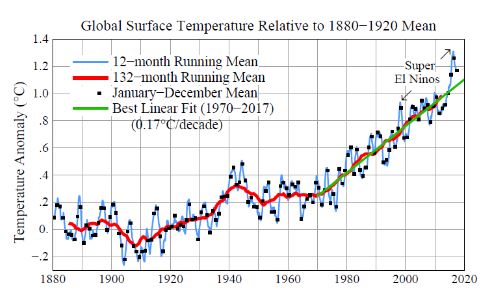
The IPCC takes the average of the 1850 –1900 period as the baseline, then takes current warming as the observed global mean
surface temperature (GMST) for the decade 2006 – 2015. On this basis current warming is 0.87°C.
Hansen et al use the 1880 – 1920 period as a starting point, mainly because comprehensive global measurements are not available before 1880.
They use a linear trend line from 1970, when temperatures seriously started heading north. This gives them warming of +1.07°C at the end of 2017. The year 2017 itself was +1.17°C, the second highest ever with NASA GISS, with the last three years above the trendline. The 2017 result caused concern, because it followed two strong El Niño years and would normally be expected to fall below trend. So the trend may be quickening, time will tell.
The IPCC data gives the impression that there is significant head-room, or burnable carbon.
The last 17 of the 18 warmest years on the 136-year NASA record have occurred since 2001. We should monitor the temperature, by all means, but head back to 350ppm as soon as possible. We’ve already gone too far.
See my 2014 post The game is up and in July 2017 Can we get to 350ppm?
NASA GISS even show a 0.9°C gain since 1951-80:
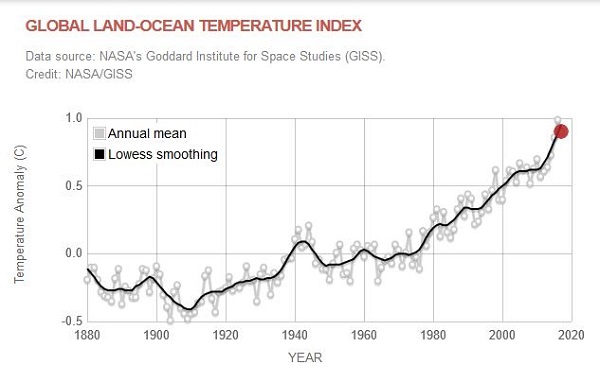
2. Carbon Brief climate update
Carbon Brief’s quarterly State of the climate report highlights a new record for ocean heat content and a growing El Niño. First here’s their temperature graph showing all the main series:
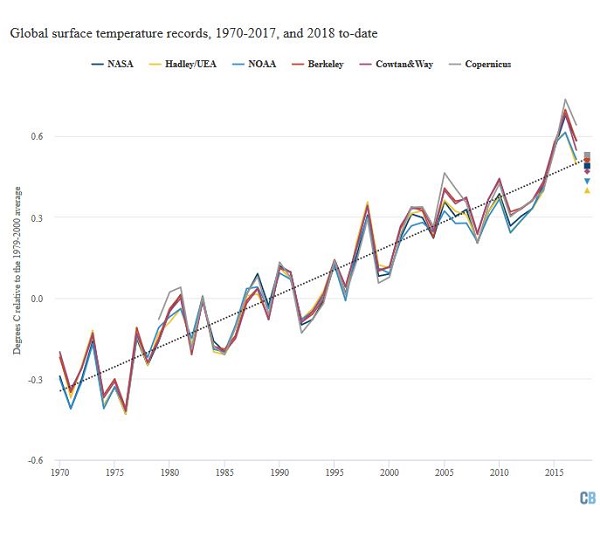
2018 is shaping to be the fourth warmest after the previous three years (2015-2017) despite a moderate cooling La Niña event during the first half of the year. However:
- A growing El Niño event in the tropical Pacific, which is discussed in detail in the following section of the article, will likely contributing to slightly warmer temperature anomalies for the remaining three months of the year.
Upwards of 90% of the heat trapped by human-emitted greenhouse gases goes into the oceans, so this is one of the graphs that must flatten if we are going to have any luck in containing global warming:
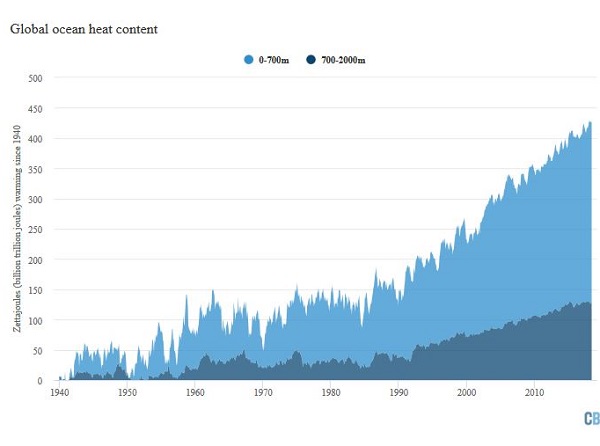
Unfortunately no evidence of progress yet.
3. Earth’s oceans have absorbed 60 percent more heat than previously thought
The paper Quantification of ocean heat uptake from changes in atmospheric O2 and CO2 composition adds to an earlier paper Revision of global carbon fluxes based on a reassessment of oceanic and riverine carbon transport.
Seems the carbon isn’t where they thought it was, and there is more of it and more heat in the ocean than they thought.
I imagine this will have implications for climate models and climate sensitivity, if other scientists take the results on board.
I’m waiting for more learned and informed comment. I think the authors are saying whatever the world thought it would have to do to fix the climate, now they will have to do 25% more.
4. Humanity has wiped out 60% of animal populations since 1970, according to WWF
-
Humanity has wiped out 60% of mammals, birds, fish and reptiles since 1970, leading the world’s foremost experts to warn that the annihilation of wildlife is now an emergency that threatens civilisation.
The new estimate of the massacre of wildlife is made in a major report produced by WWF and involving 59 scientists from across the globe. It finds that the vast and growing consumption of food and resources by the global population is destroying the web of life, billions of years in the making, upon which human society ultimately depends for clean air, water and everything else.
“We are sleepwalking towards the edge of a cliff” said Mike Barrett, executive director of science and conservation at WWF.
The Guardian article carries a picture of cattle grazing where the Amazon rainforest once grew:
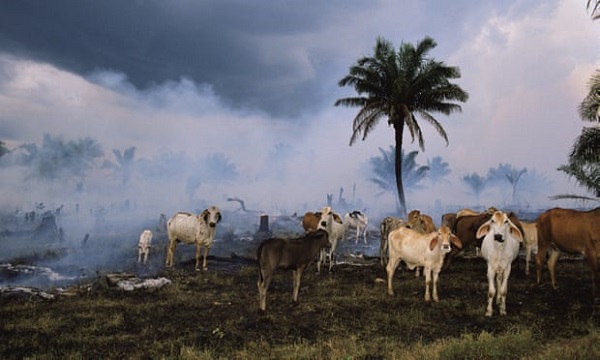
5. Food from bacteria grazing on hydrogen
George Monbiot has a suggestion as to how to feed ourselves and fix the planet at the same time. Firstly, we could all become vegetarians. That would require 76% less farmland.
Sorry George, we tried and it didn’t work for us.
Then he tells of a bright idea being developed by the Finns. Using electricity (renewable, of course) and water to make hydrogen, they then set loose a mob of bacteria to graze:
- This sounds like science fiction, but it is already approaching commercialisation. For the past year, a group of Finnish researchers has been producing food without either animals or plants. Their only ingredients are hydrogen-oxidising bacteria, electricity from solar panels, a small amount of water, carbon dioxide drawn from the air, nitrogen and trace quantities of minerals such as calcium, sodium, potassium and zinc. The food they have produced is 50% to 60% protein; the rest is carbohydrate and fat. They have started a company (Solar Foods) that seeks to open its first factory in 2021. This week it was selected as an incubation project by the European Space Agency.
I gather that what you get is a kind of meal likely to be used as a bulk ingredient in processed food, but it requires 20,000 times less land than growing soya, and Monbiot says, watch this space, this is only the beginning.
6. The Trump administration knows the planet is going to boil. It doesn’t care
Bill McKibben tells us the Trump administration:
- provided the rationale for scrapping President Obama’s automobile mileage standards: because Trump’s crew now officially expects the planet to warm by 4C . In the environmental impact statement they say it wouldn’t make much difference to the destruction of the planet if we all keep driving SUVs.
7. Climate change will displace millions
A World Bank study (download here) of three regions – Sub-Saharan Africa, South Asia, and Latin America – could see just over 143 million people forced to move within their own countries to escape the slow-onset impacts of climate change. Those regions comprise 55% of all development world population.
This map shows population density on the planet:
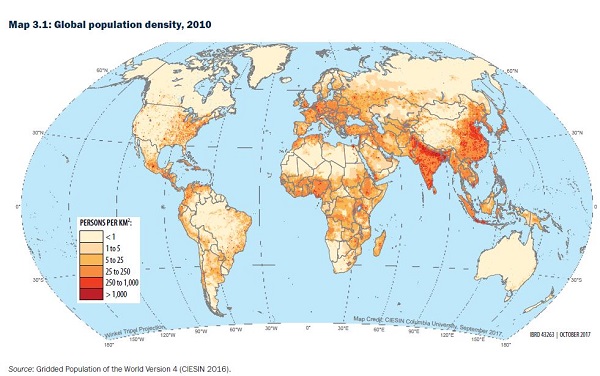
Here we have broad fertility rates and population forecasts:
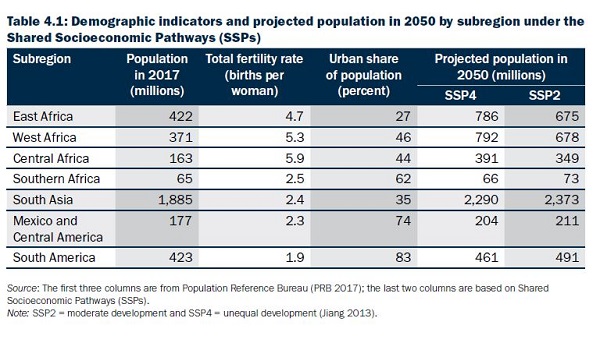
8. NOAA forecasts 60% chance of alert level one for the great Barrier Reef
The US National Oceanographic and Atmospheric Administration (Noaa) has forecast a 60% chance that the entire Great Barrier Reef will reach alert level one, which signals extreme heat stress and bleaching are likely.
That means the whole reef, including parts that were spared in 2016 and 2017.
According to the Climate Council the GBR could be hit with repeat coral bleaching events every two years by 2034. Such a short period between bleaching events is not sustainable as the development of coral assemblages takes at least a decade.
In the future bleaching will occur in La Niña years as well as in El Niño years.
You will recall that the recent IPCC report said:
- Coral reefs would decline by 70-90 percent with global warming of 1.5°C, whereas virtually all (> 99 percent) would be lost with 2°C.


Population is a key part of the problem. Most of the developed world would have reducing population if it wasn’t for immigration. So what made a difference in these countries?
1. Women became educated and no longer saw their role as breeders dependent on male bread winners.
2. Improved health and nutrition meant that mt all babies lived to adulthood. Women no longer had to have a lot of children to be sure at least some survived.
3. Effective, legal birth control including abortions.
4. Effective social welfare systems that meant that people didn’t need to have a lot of children to support them in their in their old age.
5. Increased education and restrictions on child work made raising kids a lot more expensive. Fewer kids living on farms a factor here.
6. A general feeling that the world was overpopulated and didn’t need every woman to have kids.
In the world in general, modern transport systems and a feeling that we should help others during famine and plagues has kept some populations at near crisis levels.
Suggests that we should be investing in research/action re ways of reducing the impact of sea warming on coral health and moving coral at risk to cooler places.
Keep in mind that bleaching is about loss of algae in the polps . We may actually be able to make some types of coral more heat proof using algae transplants.
We seem to be unable to rapidly drop our emissions so we do need to think about adaption in general, not just for coral.
Often when I look at the stats at the end of each day I find someone has sought out old posts I had long forgotten relevant to the latest offering. Last night there were three such.
First Ocean heat content and Earth’s energy balance from 2013, which still has useful information.
Back then scientists were using the Argo System of bouys which had been deployed from 2007. It always had limitations. The new methodology is meant to overcome these limitations. It will be interesting as to whether the experts in that field accept the new methodology which produces markedly different results.
Second, Paul Hawken’s Drawdown a ‘must read’ has had a steady flow (trickle tbh) of visitations since posted in December last year. His top single solution to the planet’s is educating girls and family planning.
Third, Where will we be in 250 million years time? posted last October, still gets visits.
I like the last bit about where temperature typically:
To judge what is meant by “slowly” I would refer to James Hansen’s Iowa Testimony, where figure 11 gives what we are doing now compared to ‘natural’ change during the Cenozoic Era:
If you take the first at face value we are pushing the planetary system 20,000 times harder than ‘normal’. Nature, that is evolutionary adaptation, can’t keep up, leaving aside that we are swarming over the earth in plague proportions, with capacity to move mountains.
BTW I think the Iowa Testimony dates from about 2007.
Posted on Saturday afternoon at SMH is an article by Nichole Hasham headlined Former UN climate chief says world doesn’t need Australia’s ‘toxic’ coal. It begins with:
IEEFA is saying similar things.
This news is a bit old, but a group called “Solar Citizens” emailed supporters 8 days ago (around 29th October) with this:
Thanks to the hard work of thousands of people [……] on Wednesday morning Federal Energy Minister Angus Taylor ruled out abolishing the Small-scale Renewable Energy Scheme (SRES) nine years early.
Angus Taylor quoted from around 24th October?
Ambi the Slow
Posted late yesterday at the SMH was an article by Nicole Hasham headlined Government experts say plan to prevent animal extinctions is failing. It begins with:
The Australian Senate’s inquiry into Australia’s faunal extinction crisis is examining the march towards extinction of Australian species. The Threatened Species Scientific Committee (TSSC) Submission is #151. There are 341 submissions listed.